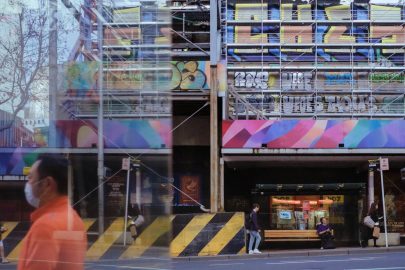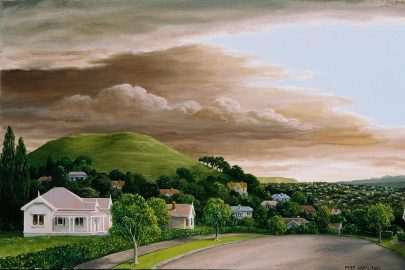Dec 1, 2014 Property
Attempts to build a “model community” in Glen Innes have gone catastrophically awry. How did that happen, and what’s been learned?
Photos by John Haydn.
“I thought, ‘You dumb old bastard.’” Engineering and arts student Nick Merrington is talking about Glen Innes resident and veteran activist Jimmy O’Dea, in his late 70s, who had been lying under a house-removal truck at Torrington Cres. “Look,” Merrington told him, “if you get out from underneath there, I’ll take your place.” O’Dea seemed on the verge of collapse. “Got any water?” he gasped. Merrington passed him his drink bottle.
It was April 2012. Merrington (21) crawled in beside the giant wheels of the house-removal trailer. He’d only come to observe, and was busy with university assignments, so he got out his books. The police summarily yanked him out and locked him in the paddy wagon.
Nick Merrington was now officially a front-line combatant in the Fight for Glen Innes.
On one side, defending their home turf, is the Tamaki Housing Group, aka Defend GI, still meeting every week — a posse of affected residents, many elderly or in poor health. There are some formidable women. They are supported by a bunch of students, Mana Movement members including Hone Harawira and John Minto, other well-known activists, diehard unionists and a group of artists.
Ranged against them are the combined might of the government, Housing New Zealand, a property development syndicate and Auckland Council.
At stake: the role of state housing and the meaning and values of home and community in fast-growing, land-hungry Auckland.
Plans to transform Tamaki — the area from Glen Innes through Panmure to Pt England and the Tamaki Estuary — have been on the books since 2003, when the Labour-led government began its revitalisation of the neighbourhood.
There were some big issues to address. Many state houses were in poor condition, some due to their age and design, others because they had been poorly maintained by Housing NZ. Many of the houses had “good bones”, but they needed refurbishment.
There was also a demand-and-supply problem. The previous National-led government had sold off some 13,000 state houses and in 1991 introduced market rents for state-house tenants. Yet much of the suburb, built at a time when land was plentiful, was under-utilised: throughout Glen Innes, there are many large sections with individual state houses.
And all the while, Auckland’s perennial problems — a growing population, chronic housing shortage and ever-rising house prices — were gathering momentum.
The solution, in part, was a state-house community programme with increased density, led by Housing NZ. Its flagship was Glen Innes’ Talbot Park. In 2007, clusters of architect-designed houses were built around refurbished star flats and parkland to become, with the support of intensive tenancy management, a carefully constructed mixed community.
Wouldn’t everyone benefit if some of the prime land could be sold at market values — with some of the proceeds used to build better housing, and better communities?
After the National-led government came to power in 2008, Housing NZ’s role at the heart of social housing development was reduced. Non-governmental housing providers and private-sector developers were invited to step up. Talbot Park suffered as tenancy management became a lesser priority.
GI didn’t simply have problems to be fixed; its green accessible spaciousness also offered commercial opportunities. With about 57 per cent of GI households state-owned, wouldn’t everyone benefit if some of the prime land could be sold at market values — with some of the proceeds used to build better housing, and better communities?
Glen Innes, in the words of developer Murdoch Dryden, could become “a model community for how private and social housing should work together”.
The trucks came at night, intent on carting away state houses from several parts of the suburb: Silverton Ave, Apirana Ave, Merfield St, Lyndhurst St, Castledine Cres. The darkness didn’t stop the protests, which were frequently violent. Nick Merrington was injured often — concussions, bruising, cracked ribs — from being “smashed against the road”.
Glen Innes resident Marion Peka protested at the Silverton Ave removal. “I’ve never been pushed around like that before. I’ve never had somebody grab my throat,” she said on a YouTube clip.
https://www.youtube.com/watch?v=4z18QQ7vfLU&feature=share
Fellow resident and feisty Tamaki Housing Group member Yvonne Dainty needed hospital treatment after hitting her head on the ground and suffering a seizure. Protesters claim she was shoved. The police said she fell.
The battle of Lyndhurst St was one of the fiercest. Around 100 protesters faced off against 50 police, who herded the activists into Taniwha St. Jimmy O’Dea, knocked out when his head hit a kerb, was taken by ambulance to hospital.
October saw the Lunn Ave running battle, where Mana Movement leader Hone Harawira was arrested. Merrington got a call from fellow student protester Ella Grace McPherson-Newton (24), who, with Kirsty Fong (22), and Chant West, climbed onto the roof of a house loaded on a truck. They stayed there for six hours before being strapped into stretchers, lowered to the ground and arrested. McPherson-Newton has been arrested 27 times.
Merrington: “I said to Hone, ‘Are you going to get beaten up with us tonight?’ He goes, ‘Nah, I’m too old.’ But sure enough, he parked his car in front of the truck. I just remember my dad’s kind of music — I believe it was Dragon — being turned up loud in his car. Then the police came and smashed his windows and escorted him to the paddy wagon.”
The atmosphere was electric. “Everyone was amped. When the house started moving, we formed a big line and the police would smash at us and we’d all fall over. We’d get up and form another line. We did that for about a kilometre. That was an amazing night. A lot of people got injured.”
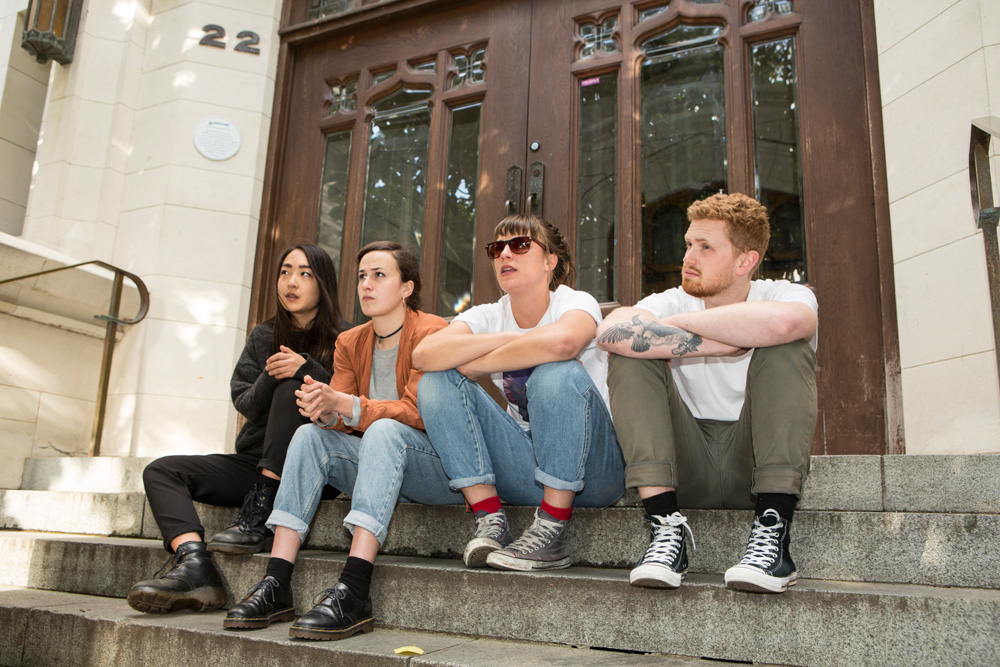
The war began six months earlier, on September 26, 2011, when 156 state-house residents in northern Glen Innes and Wai o Taiki Bay, on the banks of the Tamaki Estuary, began receiving letters from Housing NZ saying they would have to leave their homes. There were public meetings — so-called consultations — where Housing NZ and its developer, Creating Communities, outlined their removal plans.
There was anger and disbelief. “I don’t want to move. To me, this is my home,” a clearly unwell Tere Tarapu (he’s on dialysis) told TVNZ Pacific correspondent Barbara Dreaver at his Castledine Cres house.
“They didn’t even come and see us before they have this on their plan,” said his wife, Miimetua.
“I feel they are treating us as rubbish,” said Lilo Tai, whose extended family have lived there for 20 years.
This was valuable property. Average 2011 values for the land alone suggest it was worth about $60 million.
Families in Apirana Ave, Castledine Cres and Eastview Rd were among the first to get letters. Creating Communities had won the contract to purchase and develop 111 northern Glen Innes state-house properties and 45 at Wai o Taiki Bay. Housing NZ agreed to provide cleared sites and would buy back 78 new state houses from the development consortium as they were completed.
This was valuable property. Average 2011 values for the land alone ($300,000 for northern GI and $600,000 for Wai o Taiki Bay) suggest it was worth about $60 million.
In the first stage, 18 state houses would be replaced with 49 new homes, split evenly between state houses and private properties. Nine families were told to be out by July 2012; nine dwellings were already vacant.
Among the nine families were Mateora Kanuta and Tira William and their 10-year-old daughters Mikayla and Autymn. Mateora had lived in the Eastview Rd house for more than 30 years. Eventually, when Housing NZ offered another house nearby, they agreed to move.
Their loss was poignantly captured by a wall of family photos in the documentary Whare Tapa Wha shown on Maori TV in September. “This house is part of us. This house is our place,” says Mateora in 2013 as she leaves.
Her sister, Betty Kanuta, who lived in Melling St, got her eviction notice ahead of schedule. I first met Betty and other members of the Tamaki Housing Group — Yvonne Dainty, Tere Campbell, Sue Henry, Ioela (Niki) Rauti — in early 2014 at one of their weekly meetings.
Betty has lived in GI all her life — her parents moved in 54 years ago. She has a warm smile, works two jobs as a postal worker and cleaner, is a union member and is well known as a Glen Innes School walking-bus volunteer. She has also been treated for breast cancer.
Betty had planned to vigorously resist eviction. “Glen Innes state houses are not a goldmine for property developers. Hands off our homes,” read a banner on her house. Shortly after a protest in March, Housing NZ found her a replacement house in the area and Betty decided to move.
While some who have lost their homes have been resettled in the suburb, others have had to move out. Dryden insists the relocations have not turned out badly, and cites a November 2013 relocation survey by Infield International of 100 tenants, with a 60 per cent response rate.
“The data is really good. It endorses the ability to move people successfully: four per cent were neutral and felt their new home was neither better nor worse than their old home; 80 per cent felt their new home was either better or much better; 16 per cent felt they were in a worse position.”
The question remains: If 156 state rental properties are removed and just 78 built, where do the other 78 households go? “Wherever they choose,” says Dryden. They can outline their needs — a bigger or smaller house, or a different location — to Housing NZ.
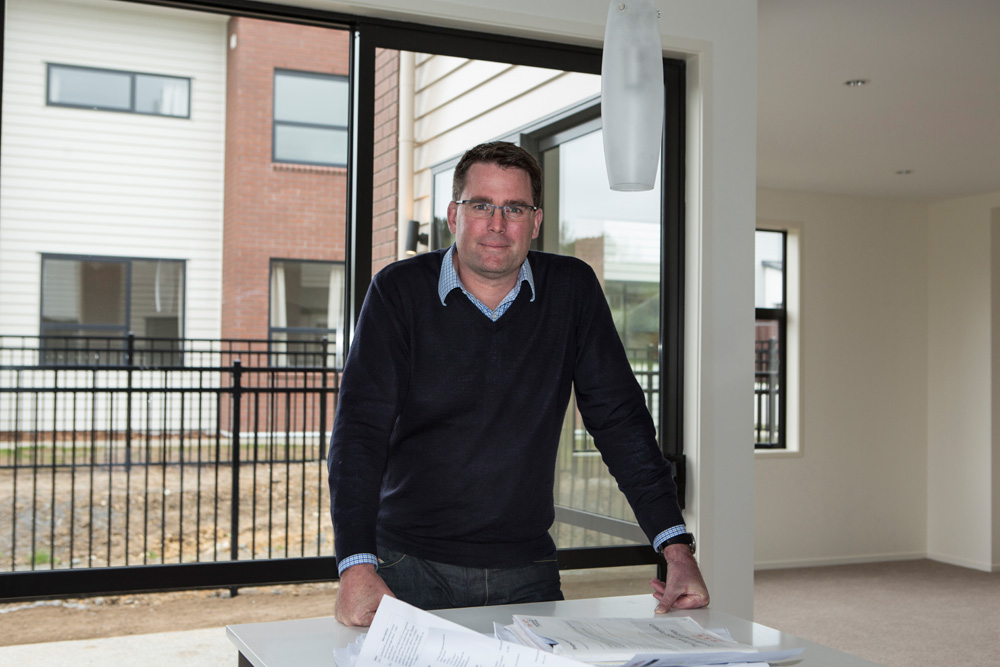
Murdoch Dryden is clearly proud of his handiwork. He’s a third-generation developer in the area: his grandfather ran the earthworks company that graded much of the suburb and his father’s construction firm built the first Nosh foodstore, at the bottom of Apirana Ave. Now, Murdoch is a director of Creating Communities, along with Hopper Developments (the group behind Pauanui Waterways), Arrow Arcus (a development arm of Arrow International) and South Auckland developer Chris Jones.
Dryden is a big fan of a new assimilation strategy called mixed tenure — private homes and state and private rentals all in together on the same streets. He takes me to the corner of Castledine Cres and Merfield St to show it off.
There are three new two-storey houses. Pick the state house. I can’t. The façades are all different; inside, the floor plans are almost identical. The privately owned dwellings have an ensuite, more expensive fittings and a double garage.
It’s state housing incognito and the revival of an older policy known as “pepper potting”. Until the late 1940s, Maori were excluded from state housing, but from 1948, with increasing Maori migration to cities, Maori families were “pepper-potted” into Pakeha neighbourhoods to encourage their assimilation.
The policy collapsed as more Maori, partly due to their lower-than-average incomes, were accommodated in state housing. Areas of concentration developed: Porirua, South Auckland — and Tamaki, planned and built in the late 1940s and early 1950s. Housing NZ still owns 57 per cent of the sections there and is said to accommodate a further 20 per cent of its tenants in the area in private rentals.
“I defy anyone to not buy into the logic of what’s going on.”
Dryden (42) grew up in an ex-state house nearby, in Edmund St, St Heliers. He says the trouble with most of the old GI state houses is that they were plonked, with little regard to the street or sun, in the middle of large 800-900sqm sites, on timber piles with steps down to the back.
Does he think they have good bones? “No, not for a moment. A lot have good bones, but you have got to strip off all the fibrolite cladding and deal with dampness issues and get rid of the asbestos out of the vinyl.”
It’s poor housing stock that needs renovating anyway, he says. And if you’ve got someone living alone in a three-bedroom house on a 900sqm section, in a city screaming “housing shortage”, why wouldn’t you move them to a better home and redevelop the site?
“I defy anyone to not buy into the logic of what’s going on.”
Creating Communities, he says, is “getting rid of 156 houses that are past their use-by date and replacing them with 78 houses which are state of the art”. It is also contracted to build 153 new privately owned dwellings, but can build more, possibly up to 213. Current density rules permit a total of 330 homes on the 156 sections which are, on average, 840sqm. At maximum density, sections would be about 400sqm, though as a Special Housing Area, even greater density is possible.
As well as 78 state houses, another requirement is 39 affordable homes — to be achieved, says Dryden, by complying with the government’s Welcome Home scheme. That is, a house for less than $550,000 to be purchased by a household with income of less than $120,000.
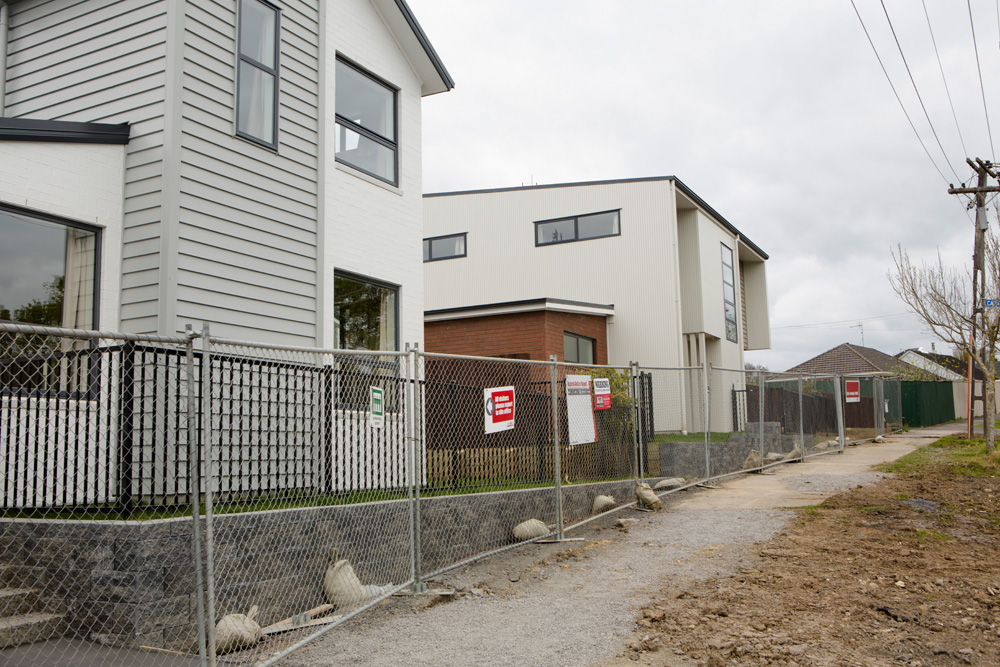
The first two three-bedroom houses sold for less than their CVs (capital valuations). They were in Merfield St, and fetched $750,000 and $770,000, against CVs of $815,000 and $835,000 respectively.
Below CV in Auckland? Unheard of: fallout from the protests, possibly, and from the graffiti attacks during the sale process.
At 45 Apirana Ave, 12 new homes have replaced three 1950s two-bedroom duplexes. Six are for Housing NZ and the others — four three-bedroom and one two-bedroom — have been snapped up from $760,000 to $795,000. The remaining four-bedroomer with a double garage has an asking price of $900,000.
Dryden wonders if he’s selling too cheaply and he’s frustrated by the slow progress — just 24 new homes have been built. (They haven’t started yet at Wai o Taiki Bay, though, where state houses with sea views will make way for multi-million-dollar mansions and Creative Communities will make a killing.)
Already, the speed at which the new houses have been sold shows the area is highly desirable. Perhaps, in the Auckland market, it’s even a bargain. I suggest that with good design and tenancy management, such as briefly occurred at Talbot Park in 2007, it’s possible to create good state-rental communities.
“While I have got a lot of sympathy for [them], they are not actually getting put out in the street.”
“Yes,” says Dryden, “but if you set up an environment where it self-polices, then you’re not reliant on someone walking around with a stick.” Self-policing — does that mean property-owning neighbours complaining when state renters move in and lower the tone? Dryden is convinced it will work. “I don’t think putting all the poor people in the same place is the answer.”
Many of the residents of Glen Innes have successfully brought up families there over a couple of generations. Doesn’t that show that long-term renting — the original “house for life” policy — works?
“There are not many people in private rentals who have had the luxury of being in a house for 50 years, so there is a double standard there. While I have got a lot of sympathy for [them], they are not actually getting put out in the street.”
A house for life was once considered the New Zealand dream. Does that only apply to those who can afford to buy?
“I’m sceptical that the ‘house for life’ was anything other than a slogan,” says Dryden. “I’m not sure it’s ever been codified in law.”
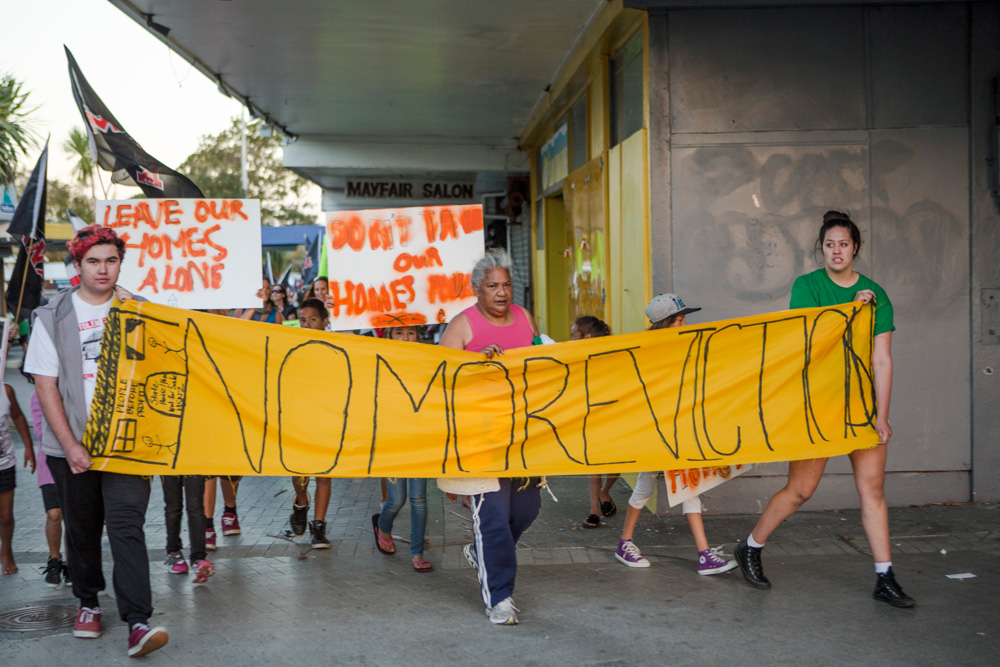
Actually, it has. In Clairville Cres, housing lobbyist Sue Henry lives in a solid, tiled state house with her partner, Ken Underwood, 87. A naval gunner in World War II, he was allocated the house in 1956 under the Tuberculosis Act. This provides for lifelong “special accommodation” for returned servicemen suffering from the infectious lung disease.
“What this is all about is economic cleansing.”
When the pair received their letter telling them they would have to leave, Henry was incensed. “What this is all about is economic cleansing,” she told the East & Bays Courier. “Poor people are being shunted around and having their homes taken off them to make more money.”
Henry highlights what many think is really happening in GI — a massive land grab intended to push out the poor and colonise the suburb with wealthier owners. Hence the chants at protest marches: “One, two, three, four. Stop the war on the poor” and “Housing rights are under attack. Stand up. Fight back.”
Michael (68) and Moepai (67) Temata have raised five children and welcomed many grandchildren into their state house over 47 years.
“When we received the letter saying we would have to move, we both broke down and cried,” Moepai told the East & Bays Courier in October 2011. Housing New Zealand retrofitted the home in 2009 to make it wheelchair-accessible for Michael after his legs were amputated due to complications with diabetes.
Michael made several improvements himself, building a deck, a carport, paving and cementing pathways, planting fruit trees and putting up a fence. The couple have yet to be relocated.
Some of the houses removed at night by Housing NZ were trucked north for homeless families in Kaitaia. Nick Merrington says that’s stopped. “They are no longer moving houses. They are just demolishing them now because it is easier. In the space of a couple of weeks, they demolished about eight. Some are the better houses in the area.”
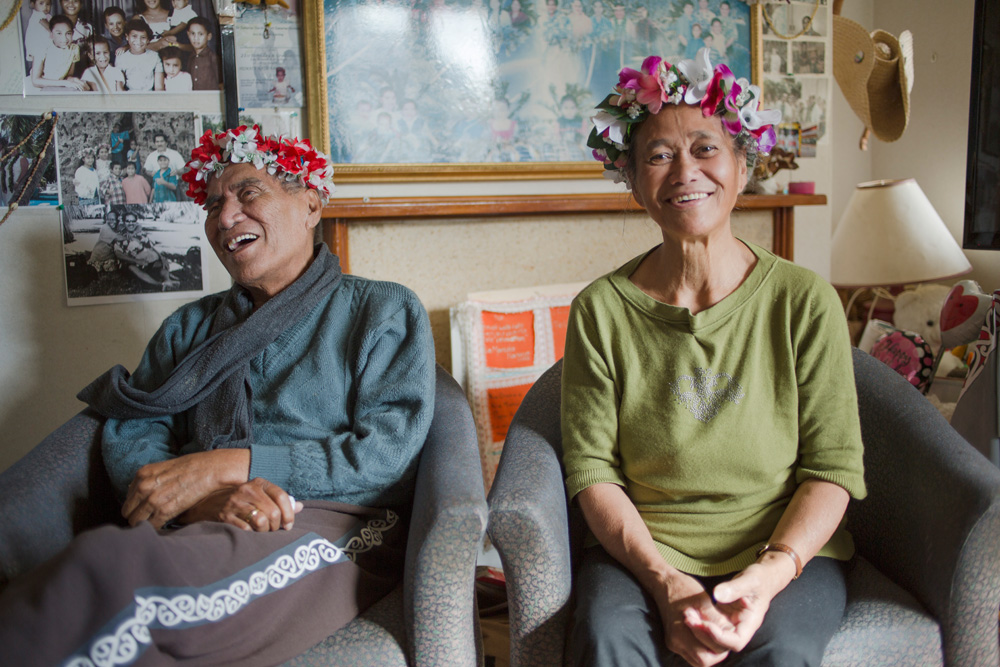
The chief executive of Housing NZ, Glen Sowry, is explaining the new vision for GI, down to such details as letterboxes.
“You see those green Dalek things?” he says. “From this year, we are no longer putting those in.” There’s also a white square one. “Whenever you see those, you can guarantee it is one of our properties.”
Such telltale signs are not in the future vision. “We call it blind tenure.” We’re looking at a row of camouflaged state houses on Castledine Cres. “As you create these mixed communities there should be no stigmatising or obvious Housing NZ homes.”
Sowry took the job in January last year knowing the government wanted 20 per cent of all social housing to be provided by the community housing sector within five years and that his organisation would be shrinking. In early October, new Housing Minister Bill English signalled a further sell-down of Housing NZ’s 69,000 housing stock worth about $17 billion, and said he would be happy for that percentage to rise.
“Coming from a background of competition, I’m very comfortable with that,” says Sowry, who was previously operations manager for Air New Zealand.
Details of how Housing NZ shrinks — asset transfers and the like — are still being worked out. Meanwhile, the ministry has been shedding roles and funding.
First, the Special Housing Unit (SHU) within the Ministry of Business, Innovation and Employment now allocates a new Social Housing Fund. From July 2011 to the end of 2013, it gave $123 million in capital grants to Community Housing Providers (CHPs). A further $18 million is on the way.
Housing NZ no longer decides who gets a state house: that’s the role of the Ministry of Social Development.
With CHPs chipping in about $150 million, the total funding of $273 million is expected to bring 774 new social and affordable homes. Examples of CHPs include: Accessible Properties, a subsidiary of IHC; Airedale Property Trust, assisted by the Methodist Church; and Te Runanga o Ngati Porou. CHPs, says Sowry, provide “wraparound services” to tenants with particular needs “in a way that we at Housing NZ are not”.
Second, Housing NZ no longer decides who gets a state house: that’s the role of the Ministry of Social Development (MSD). “If you are going to create a contestable market of suppliers, then it wasn’t appropriate for Housing NZ to be the arbiter of need,” says Sowry. He adds that the MSD is better placed to take a “holistic view” of a tenant.
A third reform accompanies those two: a revised policy of reviewable tenancies. “There are a reasonable number of people who live in a Housing NZ house today that arguably don’t need it,” says Sowry. Under new periodic tenancy reviews (conducted by MSD), some tenants, even those paying market rents, will be moved out to provide for those with greater needs.
Sowry says he wants to bring the customer-focus emphasis learned from his time with Air New Zealand — “we are a people business” — to Housing NZ. In his first month, he set out to meet “the people in all the organisations who throw rocks at us”.
He fronted up to GI school principals, the police and the Panmure Community Action Group — who had “pretty strong views” about northern GI. He didn’t, however, talk to the Tamaki Housing Group, although they did try to talk to him, protesting outside his Glendowie home when he wasn’t there.
He traces most of the problems back to the Creating Communities contract, a legacy he inherited.
“Anyone could do the arithmetic and see the number of Housing NZ houses was halving. Not surprisingly, the community said: ‘There are fewer state houses for us to live in. What are you doing?’”
Indeed. So, will the number of state houses — currently 2800 — in Tamaki halve? “My commitment is when we do redevelopments going forward, we will maintain our footprint in the Tamaki area,” says Sowry, vaguely.
He acknowledges that if you turn what has been overwhelmingly a state-housing suburb into a pepper-potted area, the proportion of state houses will decline. He also acknowledges the resettlement process was poor, especially for families who have lived in their homes for 40-50 years. “That’s the bit that arguably we didn’t manage well enough.”
“These houses are frankly a blight on our reputation, They are terrible to live in. They are not healthy.”
We drive along Taniwha St and turn into Fenchurch, the next area of redevelopment. The state houses here — “Austrian pre-cuts” — are a smaller, crude design. “They were built straight after World War II, principally for returned servicemen and designed to last 10 years,” says Sowry.
“When people talk with pride how they’ve bought an ex-statey and it’s got great bones, they certainly don’t mean one of these. They are frankly a blight on our reputation, They are terrible to live in. They are not healthy.”
He shows me the Taniwha St sites where 11 new homes are under way and near Sunnymead Rd where 23 homes will be built. After that is Overlea Rd. Many of the houses seem vacant.
“Some of them are [but] not because we have issued 90-day notices,” says Sowry. “If someone moves out then we probably leave the property vacant until we start building. That means less disruption for the community.”
New houses in the area also provide a drawcard for tenants to move. “Think of it as a rolling wave,” he insists. “We are creating forward capacity.”
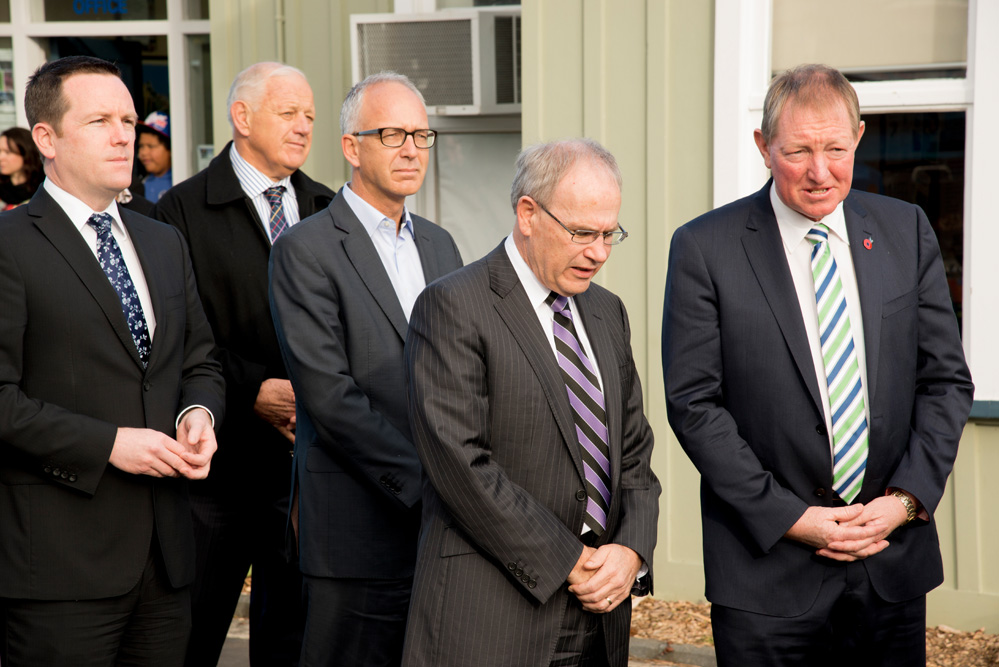
August 7, 2014, 9am. Dignitaries are gathering inside the grounds of Glenbrae Primary School, on Leybourne Circle: the then Minister of Housing, Nick Smith, Auckland Mayor Len Brown, local councillors, board members, local MP Simon O’Connor, Glen Sowry, home construction company boss David Hay, a Tamaki Redevelopment Company general manager, Peter Fa’afiu…
Also gathered is a small vocal group of protesters, their banner — “Tamaki is a community, not a company. People B4 profit” — unfurled at the school crossing. Mostly they’re ignored.
Inside the school hall the mayor is getting down with the kids. “They told me today it’s the Smith and Brown show,” he hams. “We love Tamaki. We love GI. We love Panmure and these parts of the community,” he raves. Inevitably he sings.
Earlier, one of the school trustees has bravely raised how the GI relocations have wreaked havoc on school rolls. “We need the children to start from Year 1 to Year 6 or Year 8 in the same school, not moving around, as they may miss their chances and miss their education.”
Brown proclaims the virtues of “the Tamaki principle”: “The people who get the first choice of the first new homes are those who live here.”
Smith states the promise slightly differently. “Mayor Brown rightly mentioned the very important Tamaki commitment — that anybody that is affected by the redevelopment, we are making a commitment they will be able to stay in this community.”
“Shame, Len Brown, shame. You have come into our community and destroyed it.”
A pleasing result for the protesters? Not entirely. Nick Merrington says the Tamaki Housing Group will be keeping a close watch on what happens with the next wave of resettlements. And there is no doubt about the scale of the assimilation project and the new concentration of privately owned dwellings. “It is the government’s ambition over 20 years to increase the number of houses [in Tamaki] by about 6000,” says Smith. By then, home owners will rule.
At the official sod turning of the new Glenbrae Early Childhood Education building, Smith and Brown try to outdo each other in spade skill. Smith jumps with both feet onto his spade. There’s an awkward moment. The pair forget about the blessing, so when the kaumatua arrives, they have to do it again.
A handful of protesters line the school fence: “Shame, Len Brown, shame. You have come into our community and destroyed it. Shame on you, Nick Smith. Shame on you for daring to come in here and spread your lies.” No one is listening.
Smith and Brown are here to promote a new model. They’re full of reassurance — despite the protests and evictions — that all is now well. The development on display is part of the Fenchurch Regeneration, the first Tamaki Redevelopment Company (TRC) project in GI: 34 new state houses, an early childhood education centre and the transformation of an unused Scout hall into a community hub. An integrated community plan.
The TRC is a joint venture between the Crown (59 per cent) and council (41 per cent). It emerged in 2012 with $8.5 million in government funding, boosted in August with an additional $9.6 million over three years. Its role is to act as a go-between to smooth community tensions and advance progress.
Fa’afiu, the firm’s communications and stakeholder engagement chief, has street cred. “I was raised in three state houses on this one street — Leybourne Circle. That’s my hood,” he tells me. “It was a great neighbourhood, I enjoyed my childhood here.”
When he was 13, his parents, shift workers, bought a state house in Panmure under the Housing NZ equity scheme of the early 1990s, and he attended Sacred Heart College.
“It was terrible — cold, damp. My brother got rheumatic fever when he was six.”
Born in Samoa, Fa’afiu was the one who looked after his siblings when his parents went to work: “You grow up very quickly in that situation.” After university, where he studied law, he worked for the Ministry of Foreign Affairs as a diplomat, mainly in Indonesia, and had a stint at NZ Post.
How has he found the return? “Coming back — same old. I’m very surprised that the movement has been as slow as it is.”
Did he find a community? “It was definitely still a community. You still have that strong sense, but it’s hard being a community when — look at these houses — they’re living in these shitty homes.”
Was it like that when he lived here? “They were shitty homes, but they were warm homes because of the love of your parents and your family. One of our three homes in Leybourne was a pre-cut. We were in it for only about three months. It was terrible — cold, damp. My brother got rheumatic fever when he was six.”
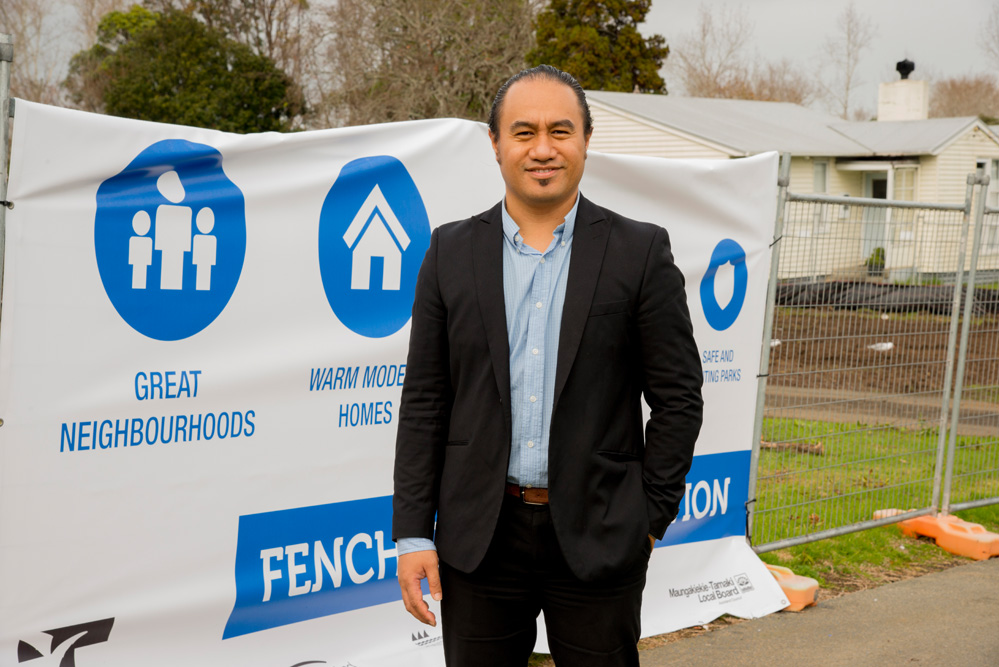
Peter Fa’afiu talks about urban regeneration in a way that makes you wonder why everyone else found it so hard. He starts with the idea of a “social licence” — a concept he nicked from the oil industry. It means, does the community want you there?
“When I arrived, I said, ‘Did northern GI have that social licence?’ And the answer is, ‘No,’ and the remnants of that is the graffiti [on the first new houses] and the protesters.”
Fa’afiu notes the two state houses that were removed to make way for 11 had been empty for 12 to 18 months. “This is a lesson learned — redevelop houses on empty sites rather than interfering with the daily lives of families.”
“The overriding comment was, ‘Less hui, more doey.’”
He says his social licence to proceed comes from 1100 responses to a survey sent out last year to the community of 16,000. “The overriding comment was, ‘Less hui, more doey.’ We have got to stop consulting and get on with it in partnership with the community.”
Right now, that includes setting up a group to run the new community hub on Fenchurch St and holding a Special Housing Area workshop for property owners in Panmure, where the next neighbourhood development is planned.
Tensions still simmer. The Tamaki Housing Group is still not happy. In late January a workshop at the Glen Innes Library was shut down when it was invaded by the THG and other protesters, some yelling, “You have no mandate!”
Does Fa’afiu’s company try to engage with them? “Yes we do. We would love constructive feedback. But when you curse and scream and swear in the presence of other residents who have been here a long time and want to listen… When we ask you to have a korero, saying, ‘Fuck off,’ is not the best response you can have from someone that is concerned about your community.”
Fa’afiu and the TRC are showing how redevelopment ought to be done: slowly, alongside new community facilities and without evicting people from their homes.
Their efforts go some way to repairing the damage done during the Creating Communities botch-up. But when Housing NZ inevitably begins selling land again to developers for private-ownership homes, the TRC way may be severely tested.
GI is at the centre of two big social experiments. One is the abdication of much of the government’s role in social housing in favour of community housing providers; the other is the move to mixed and blind tenure.
As more private ownership is attracted to this new prime eastern suburb, it’s hard not to see a critical mass of home owners gaining the upper hand over tenants with insecure tenure. In 10 years’ time, we will know what is left of the imperfect, but proudly GI state-house community.
The unanswered question: if the brave, new Auckland becomes unaffordable for all but the wealthy, where will those who are crowded out live?
Also on metromag.co.nz: GI Blues: Inside the Glen Innes State House “War Zone”.

